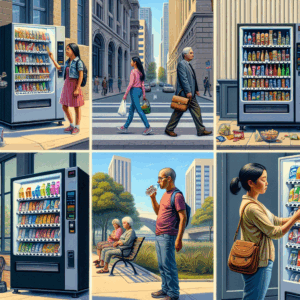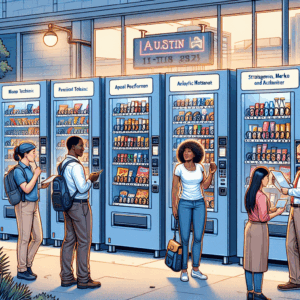Table of Contents
- Understanding Vending Machine Placement
- The Importance of Product Selection
- Maintenance and Upkeep Realities
- Legal and Licensing Requirements
Understanding Vending Machine Placement
Location, Location, Location
One of the first and most important things to consider when setting up a vending machine is its location. The placement of your vending machine can make or break your business. In my own experience, finding a high-traffic area like a school, hospital, or busy shopping center can significantly increase your chances of success.
Think about it: people are more likely to make impulse purchases when they’re in a hurry or when they’ve been walking around for a while. An ideal location is one where there’s a constant flow of potential customers passing by.
Securing the right spot often involves negotiation and some networking. Sometimes it’s just about knowing who to talk to in order to get your vending machine placed in a prime location, so don’t hesitate to reach out to local business owners or property managers.
Visibility and Accessibility
No matter how great your vending machine’s products are, if people can’t see or reach them, you won’t make a sale. Trust me, you want your machine to be visible and easily accessible. It’s crucial to place it where it’s noticeable at a glance.
Your machine should stand out but not obstruct the pathway. A brilliantly located machine that’s tucked behind a potted plant is as good as invisible. Ensure that it’s in a spot where it doesn’t blend into the background.
Another thing to think about is accessibility. Try to place your vending machine where people can get to it easily without needing to go out of their way. The placement should be intuitive enough so that a first-time visitor to the area could easily find it.
Consideration of Competition
You need to keep competitors in mind when deciding where to place your machine. Many a time, a great location might already be saturated with vending machines from different suppliers. Picking a spot that is relatively free from direct competition can give you the upper hand.
When I first ventured into vending machines, I talked to locals to understand existing vending setups and used that intel to my advantage. Be smart, and don’t dive headfirst into heavily competitive spots without a clear strategy.
Also, consider the demographics of the location. A vending machine located in an office district might do well with snacks and coffee, whereas one near a gym would do better with healthy snacks and protein bars.
The Importance of Product Selection
Know Your Audience
Selecting the right products for your vending machine is no small feat. It’s all about knowing your audience. From my time in this business, I’ve learned that the best way to figure out what will sell is by understanding the preferences of the people frequenting the area.
For example, placing energy drinks and protein bars in a gym setup is likely to attract health-conscious patrons. On the other hand, placing gourmet snacks in a busy all-natural, organic store could draw in the wrong crowd.
It’s crucial to tailor your product selection to the crowd you’re targeting. Conduct small surveys or brief conversations with potential customers to gather invaluable insights, then use that info to outline your product inventory.
Quality Over Quantity
The notion that ‘more is better’ doesn’t always hold true, especially when it comes to vending machine products. I’ve seen many peers flood their machines with a wide variety of products, only to end up with a lot of wasted stock.
Instead, I recommend focusing on quality and popular items that are surefire hits. It’s more cost-effective to keep fewer, better-quality options that you know will sell rather than packing your machine with items that may just gather dust.
The golden rule is to start small, monitor behavior, and adjust the product selection based on sales trends and customer feedback. Keep experimenting until you hit the sweet spot of the perfect mix of items.
Seasonal Changes and Trends
Adjusting your products to fit seasonal changes or current trends is where you can score big time. Over time, I’ve come to appreciate how dynamic product selection needs to be to stay relevant and profitable.
For instance, warmer months might see an uptick in the sale of cold beverages. Meanwhile, in winter, your vending machine might benefit from stocking up on hot drinks or comfort snacks. Being adaptable can significantly drive your sales throughout the year.
Keeping an ear out for viral trends can also be beneficial. If a new snack or drink becomes popular, quickly adding it to your machine could attract trend-savvy customers. Stay informed and flexible, and you’ll always have the edge.
Maintenance and Upkeep Realities
Routine Maintenance Hacks
Regular maintenance of your vending machines isn’t just optional—it’s essential for smooth operations. Early in my vending machine days, overlooking this led to machine issues I could’ve easily avoided with regular check-ups.
Make a habit of cleaning, restocking, and checking machines for any issues weekly. Trust me, consistency pays off in the long run. You’ll prevent hiccups like product jams or machine malfunctions that could frustrate customers.
Simple steps like lubricating mechanisms, checking for outdated products, and ensuring the payment system is glitch-free can go a long way in ensuring your machine runs smoothly and reliably.
Managing Technical Issues
Despite our best efforts, technical issues may pop up. It’s a good idea to equip yourself with basic technical know-how to troubleshoot common problems. I’ve handled countless technical blips, and having a basic understanding can be a real lifesaver.
Whether it’s fixing a jam or rebooting a fritzy payment system, being versed in these basics can save you time and money. Consider connecting with a reliable technician for more complex issues, as early intervention is key to preventing prolonged downtimes.
I suggest documenting any recurring issues and how you’ve managed them in the past. This kind of record-keeping can help you prevent or quickly resolve similar future problems, maintaining your service level high.
Keeps the Costs Down
Maintenance costs can accumulate, so finding ways to keep them manageable is important. From experience, preventive measures usually cost a lot less than repairs after a breakdown.
Bundling supplies, getting in touch with other local operators for parts sharing, and sticking to a preventive schedule can maintain your machines at a lower cost. Get creative and look for deals with suppliers to effectively manage your overhead.
Keeping an eye on expenses and balancing them with your profits is crucial. Remember, a penny saved in maintenance is a penny earned in profit, so never underestimate the value of proper upkeep.
Legal and Licensing Requirements
Understanding Licenses
When setting up your vending machine business, legal and licensing requirements can feel overwhelming. However, I found that grasping these early on can protect you from costly fines and help establish a legitimate business.
Different areas have different regulations, so it’s essential to research what specific licenses you’ll need. This might include health permits, business licenses, and sales tax licenses. Getting it right the first time saves a lot of headaches and ensures compliance from day one.
If you’re ever in doubt, consulting with a local legal expert or business advisor can provide the clarity you need. Double-check everything and make sure your paperwork is thorough and up-to-date.
Adhering to Health and Safety Standards
Mishandling health and safety standards can land you in hot water. Trust me, adhering to these requirements is vital for a reputable vending machine business. Ensure that your machines vend products safely and adhere to temperature regulations for perishables.
Inspecting machines frequently ensures they’re not just stockholders but safe to use for consumers. Avoid oversights by maintaining a log or checklist of maintenance and compliance procedures that you can routinely update.
Whether it’s keeping cold items at a safe temperature or ensuring snack freshness, having these standards in check builds trust with your customers and keeps regulators off your back.
Staying Updated with Regulations
Regulations can change, and it’s crucial to stay updated to keep your machines compliant. I regularly scan local news and connect with vending machine associations to ensure I’m not caught off-guard by new laws or policies.
Sign up for newsletters and bulletins from governmental bodies or industry experts. This not only provides updates specific to your area but often includes tips from seasoned pros who have navigated these tricky waters before.
Being proactive about knowing and adapting to regulatory changes protects your business from unwanted legal issues and maintains its standing as a trustworthy and lawful operation.
FAQ Section
What is the best location for placing a vending machine?
High-traffic areas like shopping centers, schools, and hospitals often provide the best spots for vending machines due to the constant flow of potential customers. Visibility and accessibility further determine a location’s success.
How do you choose products for a vending machine?
Understanding your audience is crucial to selecting the right products. Tailoring offerings to suit the preferences of those frequenting the area is key. Keeping track of sales trends can also guide product selection.
What are common maintenance tips for vending machines?
Regular cleaning, checking for technical issues, and ensuring all components work smoothly are vital maintenance steps. Routine checks help prevent breakdowns and ensure the machine operates effectively.
What legal requirements do I need to consider for vending machines?
Licensing requirements vary based on location. It’s essential to obtain necessary business licenses, health permits, and sales tax licenses. Regularly updating yourself with local regulations also prevents legal hassles.



